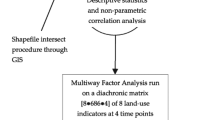Abstract
This research analyzes the relationship between protected federal lands (wilderness, national parks, national monuments and roadless areas) and nearby communities in the rural western United States. Opponents of environmental protection claim that protected lands limit the growth of nearby communities by locking up potentially valuable natural resources and restricting mining, logging and grazing. Others claim that extractive industries are no longer the backbone of rural economies— instead, the presence of protected federal lands encourages growth by attracting tourists and new residents. A geographic information system is used to calculate the proportion of protected lands occurring within 50 miles of the center of each western county. This calculation, in combination with detailed county-level data, indicates that environmental protection is correlated with relatively rapid population growth and with relatively rapid income and employment growth.
Similar content being viewed by others
REFERENCES
Aspen Times (2001). Real Estate Surges to Another Billion Dollar Year. June 10 (p. 6).
Bureau of Economic Analysis (2001). Regional Economic Information System1969-99 CDROM (REIS CD-ROM). Washington, D.C.: U.S. Department of Commerce.
Butler, M. A. (1990). Rural-Urban Continuum Codes for Metro and Nonmetro Counties. Agriculture and Rural Economy Division, Economic Research Service, U.S. Department of Agriculture. Staff Report No. 9028. Washington, D.C.: U.S.D.A.
Davis, S. K. (1997). Fighting over public lands: Interest groups, states and the federal government. In C. Davis (Ed.) Western Public Lands and Environmental Politics (pp. 11–31). Boulder: Westview Press.
Flora, C. (1990). Rural Peoples in a Global Economy. Rural Sociology, 55, 157–77.
Frome, M. (1997). Battle for wilderness. Salt Lake City: University of Utah Press.
Gulliford, A. (1989). Boomtown blues: Colorado oil shale, 1885-1985. Niwot: University Press of Colorado.
Jackson, R. H. (1995). Federal lands in the Mountainous West. In W. Wyckoff & L. M. Dilsaver (Eds.), The Mountainous West: Explorations in Historical Geography (pp. 253–280). Lincoln: University of Nebraska Press.
Johnson, J. D., & Rasker, R. (1993). Local Government: Local Business Climate and Quality of Life. Montana Policy Review, 3(2), 11–19.
Loomis, J. & Walsh, R. (1997). Recreation economic decisions: Comparing benefits and costs. 2nd Edition. State College, PA: Venture Press.
Lorah, P. (2002). Isolation in the West: From the Lycra Archipelago to the Siberia of Montana Highway Patrol Assignments. Journal of the West, Spring 2003.
Marston, B. (2001). A modest chief moved the forest service miles down the road. High Country News, 33(9), 12.
Marston, E. (2001). Economics With a Heart, But Not a Soul. High Country News, 33(24), 16.
McGranahan, D. A. (1999). Natural Amenities Drive Rural Population Change. Food and Rural Economics Division, Economic Research Service, U.S. Department of Agriculture. Agricultural Economic Report No. 781.
Patric, J. K. & Harbin, R. L. (1998). Whither Wilderness? How Much is Enough? Heartland Policy Study #88. Chicago, IL: The Heartland Institute.
Phillips, S. (2000). Windfalls for wilderness: Land protection and land value in the Green Mountains. In S. M. McCool, D. N. Cole, W. T. Borrie, and J. O'Loughlin (Eds.), Wilderness Science in a Time of Change Conference-Volume 2:Wilderness Within the Context of Larger Systems. Proceedings RMRS-P-15-VOL-2. Ogden, UT: The U.S. Department of Agriculture, Forest Service, Rocky Mountain Research Station.
Power, T. M. (1991). Ecosystem Preservation and the Economy in the Greater Yellowstone Area. Conservation Biology, 5(3), 395–404.
Power, T. M. (Editor) (1995). Economic Well-Being and Environmental Protection in the Pacific Northwest. University of Montana: Economics Department.
Power, T. M. (1996). Environmental protection and economic well-being: The economic pursuit of quality. Armonk, New York: M. E. Sharpe.
Power, T. M. (1996a). Wilderness economics must look through the windshield, not the rearview mirror. Wilderness, 2(1), 1–10.
Power, T. M. & Barrett, R. N. (2001). Post-cowboy economics: Pay and prosperity in the new American west. Washington, D.C.: Island Press.
Price, M. Moss, L. & Barrett, R. N. (1997). Chapter 12: Tourism and Amenity Migration. In B.Messerli & J.D. Ives (eds.), Mountains of the world: A global priority (pp. 249–280). New York: The Parthenon Publishing Group.
Rasker, R. (1993). Rural Development, Conservation, and Public Policy in the Greater Yellowstone Ecosystem. Society and Natural Resources, 6, 109–126.
Rasker, R. (1994). A New Look at Old Vistas: The Economic Role of Environmental Quality in Western Public Lands. University of Colorado Law Review, 65(2), 369–399.
Rasker, R. (1995). A new home on the range: Economic realities of the Colombia River Basin. Washington, D.C.: The Wilderness Society.
Rudzitis, G. (1993). Nonmetropolitin Geography: Migration, Sense of Place, and the American West. Urban Geography, 14(6), 574–585.
Rudzitis, G. & Johansen, H. E. (1989). Migration into Western Wilderness Counties: Causes and Consequences. Western Wildlands, 15(1), 19–23.
Strittholt, J. R. & Dellasala, D. A. (2001). Importance of roadless areas in biodiversity conservation in forested ecosystems: Case study of the Klamath-Siskiyou ecoregions of the United States. Conservation Biology, 15(6), 1742–1754.
Ullman, E. L. (1954). Amenities as a Factor in Regional Growth. The Geographical Review, 44, 119–132.
U.S. Census Bureau (2001). Census 2000 Redistricting Data (Public Law 94-171) Summary File. Washington, DC.
U.S. Geologic Survey (1999). Linear Federal Land Features of the United States. Reston, VA. <http://www-atlas.usgs.gov/fedlandsm.html>
United States Forest Service (2000a). National inventoried roadless areas 2000. Salt Lake City: Geospatial Service and Technology Center. http://www.roadless.fs.fed.us/documents/feis/ data/gis/coverages/index.shtm l
United States Forest Service (2000b). Forest Service roadless area conservation final environmental impact statement. Volume 1. Washington, D.C.: USFS.
Vias, A. (1999). “Jobs Follow People in the Rural Rocky Mountain West.” Rural Development Perspectives, 14(2), 24–31.
von Reichert, C. & Rudzitis, G. (1992). Rent and Wage Effects on the Choice of Amenity Destinations of Labor Force and Nonlabor Force Migrants: A Note. Journal of Regional Science, 34(3), 445–455.
Wilkison, T. (02). Ranch country gives urbanites tips on etiquette. The Christian Science Monitor. August 27th.
Author information
Authors and Affiliations
Corresponding author
Rights and permissions
About this article
Cite this article
Lorah, P., Southwick, R. Environmental Protection, Population Change, and Economic Development in the Rural Western United States. Population and Environment 24, 255–272 (2003). https://doi.org/10.1023/A:1021299011243
Issue Date:
DOI: https://doi.org/10.1023/A:1021299011243




